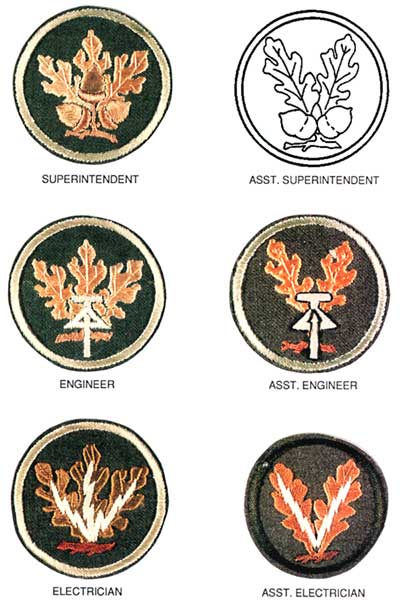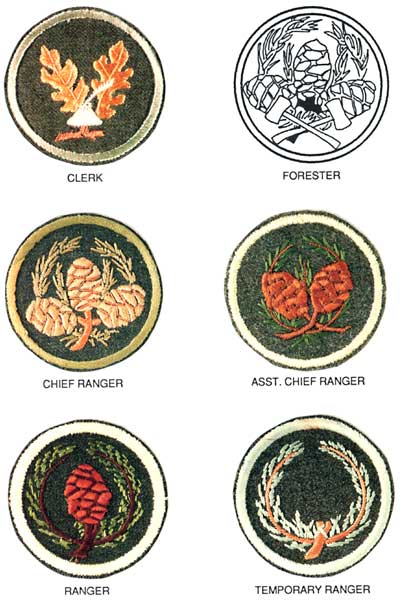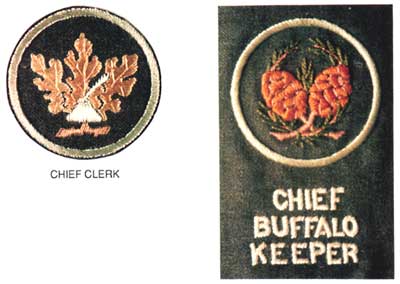|
National Park Service
National Park Service Uniforms Badges and Insignia, 1894-1991 |

|
SLEEVE BRASSARDS
The 1920 uniform regulations brought a plethora of insignia. In addition to the three USNPS collar ornaments, there were 14 patches for the sleeve. These sleeve insignia, or brassards, were to identify the rank and position of the various park employees. They were to be worn between the elbow and the shoulder on the right sleeve. These insignia were embroidered on the same material as their respective uniforms: forest green serge for officers and forestry green wool cloth for rangers. All were to be 2-1/4 inches in diameter with a 1/8-inch "light green" border.
There were three categories of brassards: for directors, officers, and rangers. The basic device for directors was four maple leaves. These were to be embroidered in "golden green," with a star in the center. The only difference between the director and assistant director was that the former had a gold star and the latter a silver one.
The basic device for officers was oak leaves, three for chiefs and two for assistants. The oak leaves were a "shaded golden yellow" with "dark brown" branches. Superintendents and assistant superintendents had "golden brown" acorns with "darker brown" cups and branches, three and two, respectively, as their identifying devices. Other officer identifiers were embroidered in white. These identifiers were:
Clerk: ink bottle and quill (only two oak leaves)
Electrician: lightning bolts
Engineer: triangle and square
Forester: crossed axes (on three colored Sequoia cones)
Although foresters were considered to be officers, their brassard did not have the customary oak leaves. Instead, for some unexplained reason, the chief ranger patch was utilized with white crossed axes.
The basic device for the rangers was stated as being the Sequoia cone, while in actuality the common denominator was a wreath. Sequoia cones denoted the relative positions of the various permanent rangers. The chief ranger had three, the assistant chief ranger two, and the ranger one. All of these were within a "dark green" wreath. Temporary rangers had only the wreath. Acorns were "light brown"; cones, leaves, and branches were "dark brown." [65]
Although the 1920 regulations listed supervisors and assistant supervisors as officers, no special sleeve device was assigned to them. The 1922 order for sleeve insignia corrected this oversight and added four more officers to the fold:
Park supervisor: wheel
Chief clerk: inkwell and quill (three oak leaves)
Park physician: PARK PHYSICIAN on bar beneath circle (two oak leaves)
Park Naturalist: PARK NATURALIST on bar beneath circle (two oak leaves)
Chief Buffalo Keeper: CHIEF BUFFALO KEEPER on bar beneath circle (brassard to be same as chief Ranger)
GAME WARDEN could also be added in white beneath the circle on any brassard.
When the contract for insignia was drawn up in 1924, a new sleeve brassard was added. This insignia, designated "unclassified," was to be used by all uniformed officer personnel not covered under the regulations. It consisted of two oak leaves on a branch.
Because of resistance to the park naturalist sleeve brassard, no new ones were ordered in 1924. The park naturalists preferred to wear the "unclassified" insignia instead. Since the park physicians also wore the unclassified insignia, it can be assumed that they objected to their insignia as well.
|
|
A design for a new park naturalist sleeve insignia was submitted by Ansel F. Hall, chief naturalist of the Service, in March 1925. The initial design was based on an eagle, but this was too intricate to be embroidered on the small patch. A simpler design was worked up, following the standard practice of the other sleeve brassards. Two samples were sent to Hall. They both had the three oak leaves of supervision, but one had a bird on it and the other a bear's head. Because of a lack of brown thread, the supplier worked the bird and bear in white. Hall approved the bear. Thus, by 1926 the park naturalists had their own distinctive insignia. Temporary park ranger naturalists wore a bear's head, worked in shaded brown, surrounded by foliage.
As the Service diversified, holders of new positions clamored for their own sleeve identification. Because most of them were not in the ranger field, they considered themselves officers. The 1928 regulations resolved the matter, declaring that only those in a command situation were to be considered officers. All others, with the exception of the rangers, were classified as employees. At the same time it was decided to eliminate the sleeve insignia from all but the ranger force.
At the 1934 superintendents' conference, it was decided that the sleeve brassard on the ranger uniform was an unnecessary expense and served no useful purpose. It too was eliminated. Patches would not return to the National Park Service uniform for seventeen years.
Basic Sleeve Brassard Devices
Directors - Maple leaves embroidered in golden green.
Officers - Oak leaves embroidered in shaded golden yellow with dark brown branches. Indentifying symbols were usually white. The superintendent's acorns and the naturalist's bear head were shaded brown. The forester used the same patch as the chief ranger, but with white axes superimposed.
Ranger - Wreath, dark green with brown stems. Acorns shaded brown.
1920



1922


1924

1926

| <<< Previous | <<< Contents>>> | Next >>> |
nps-uniforms/1/sec12.htm
Last Updated: 01-Apr-2016

